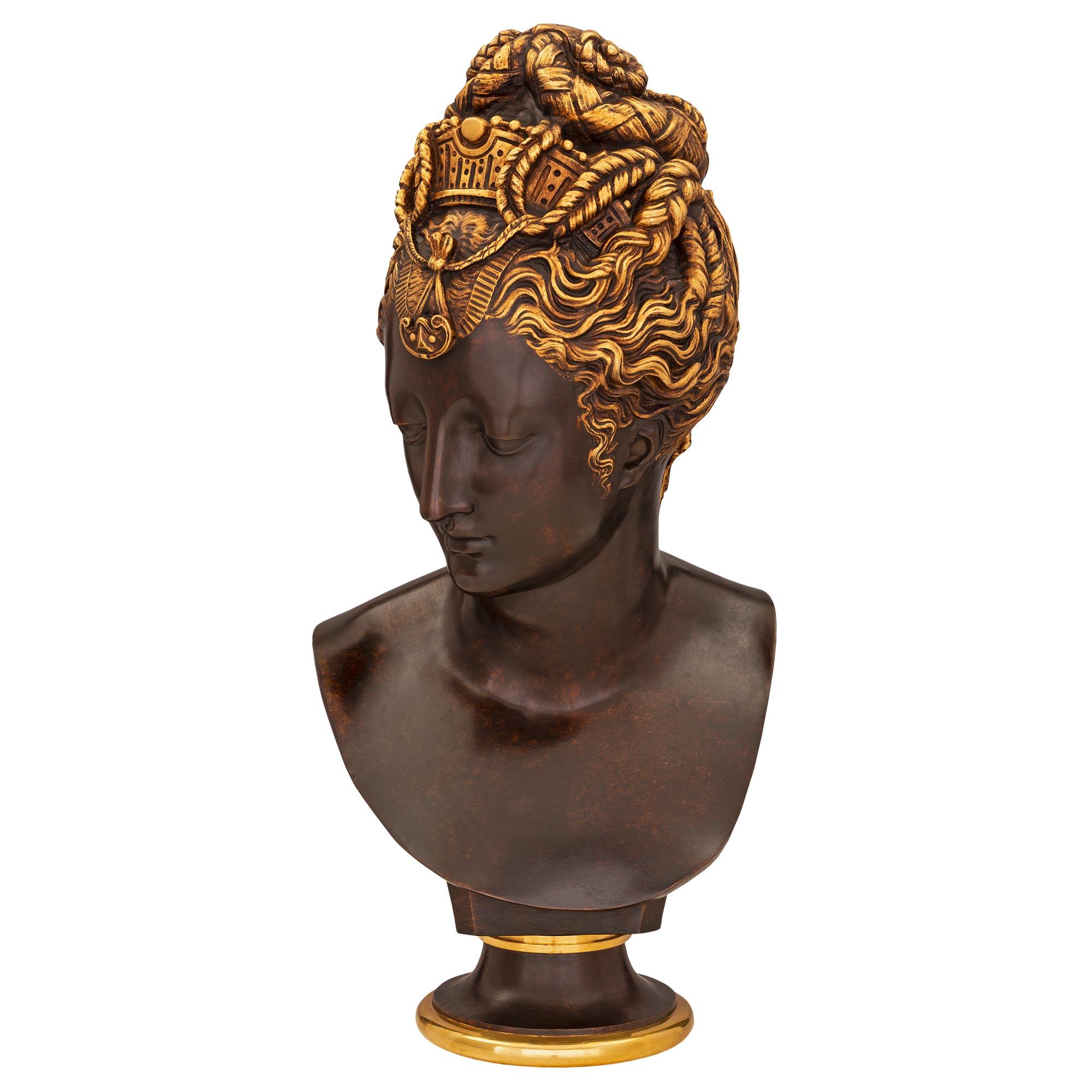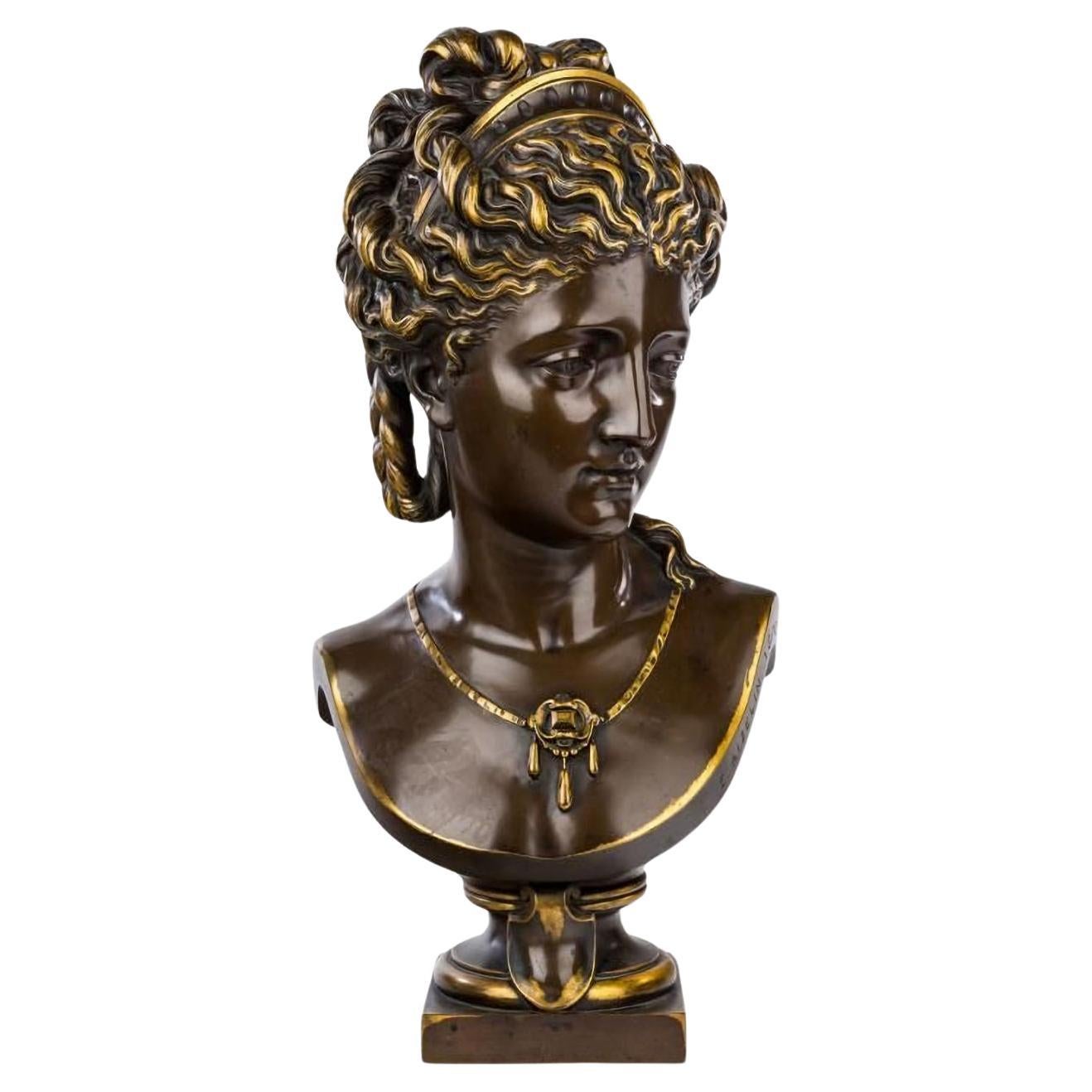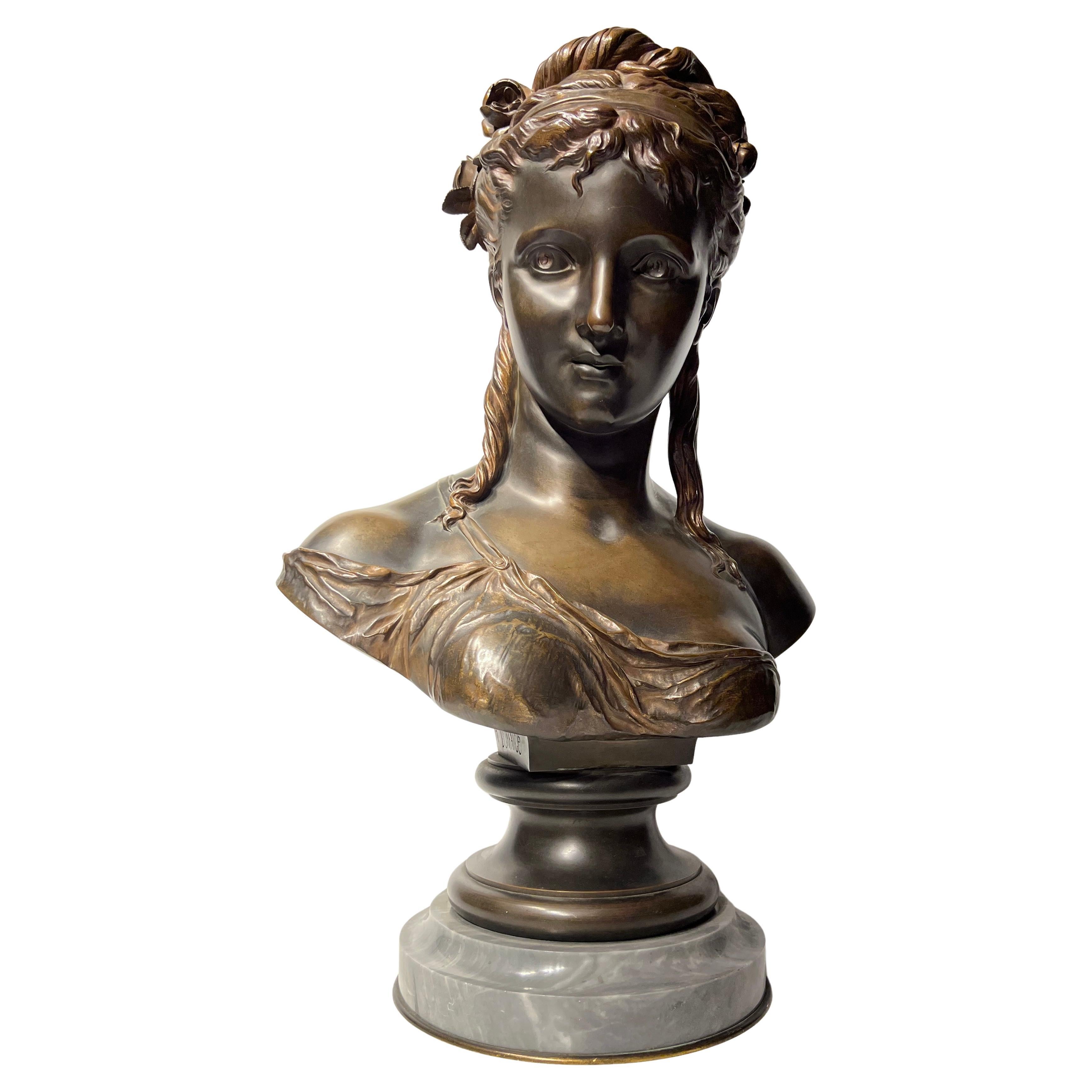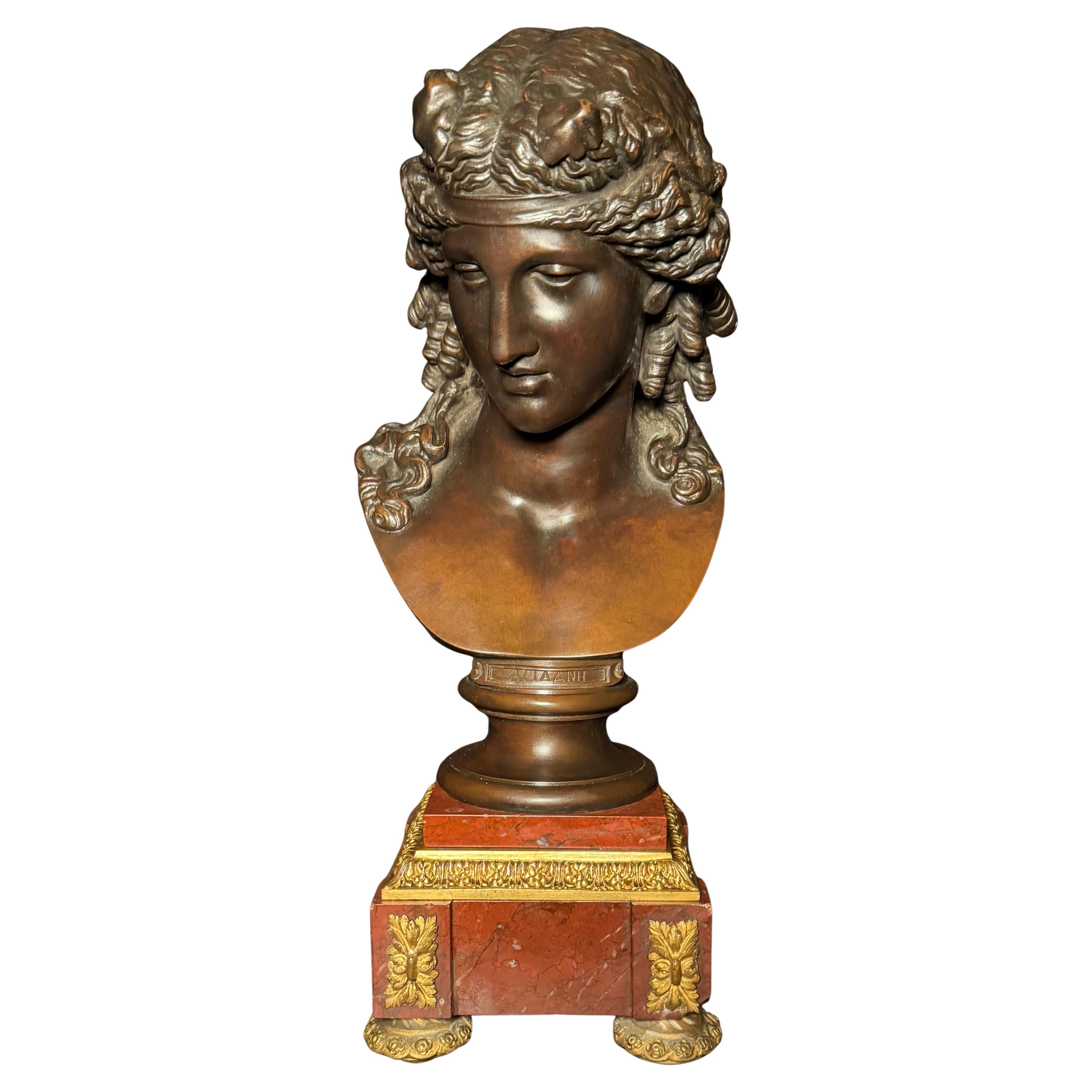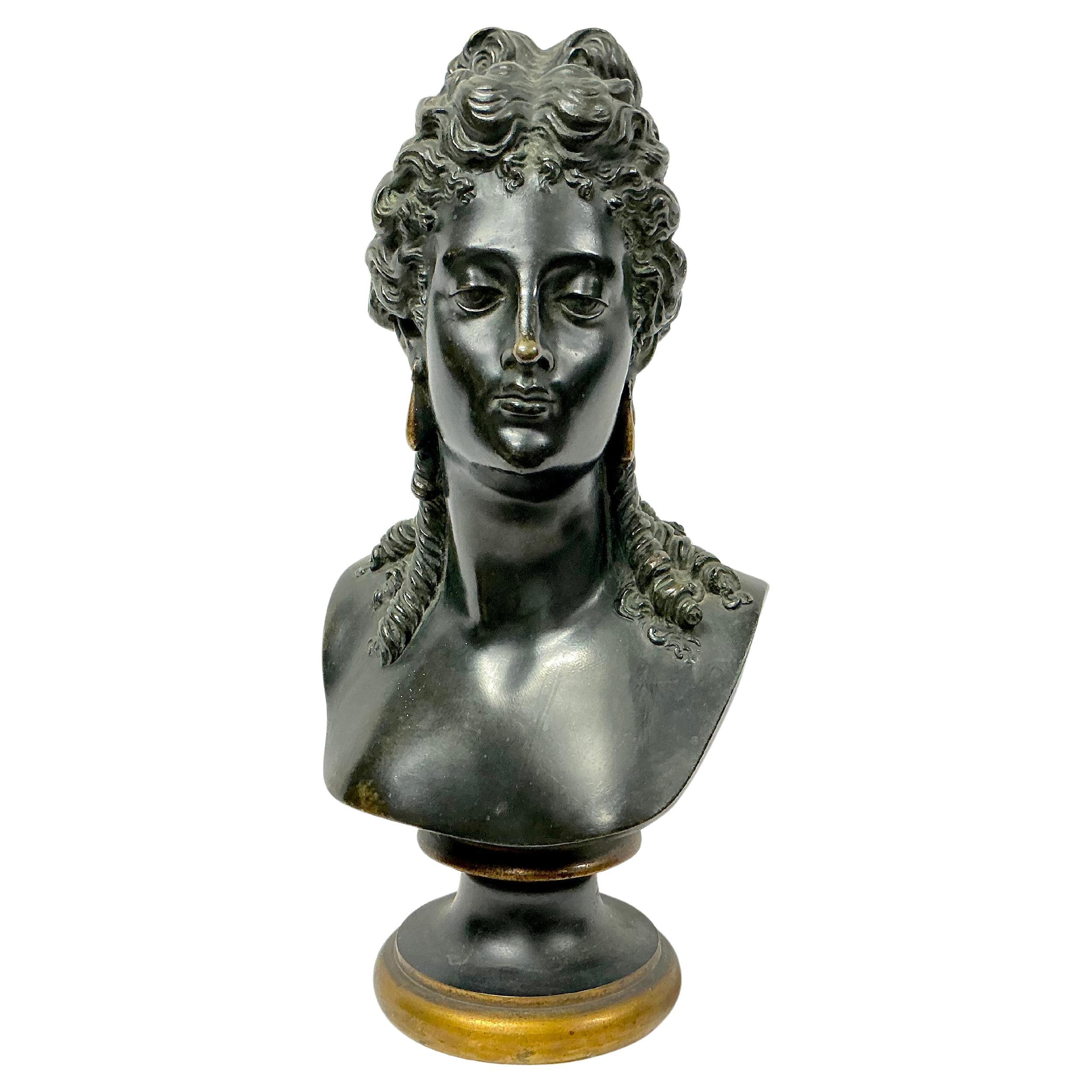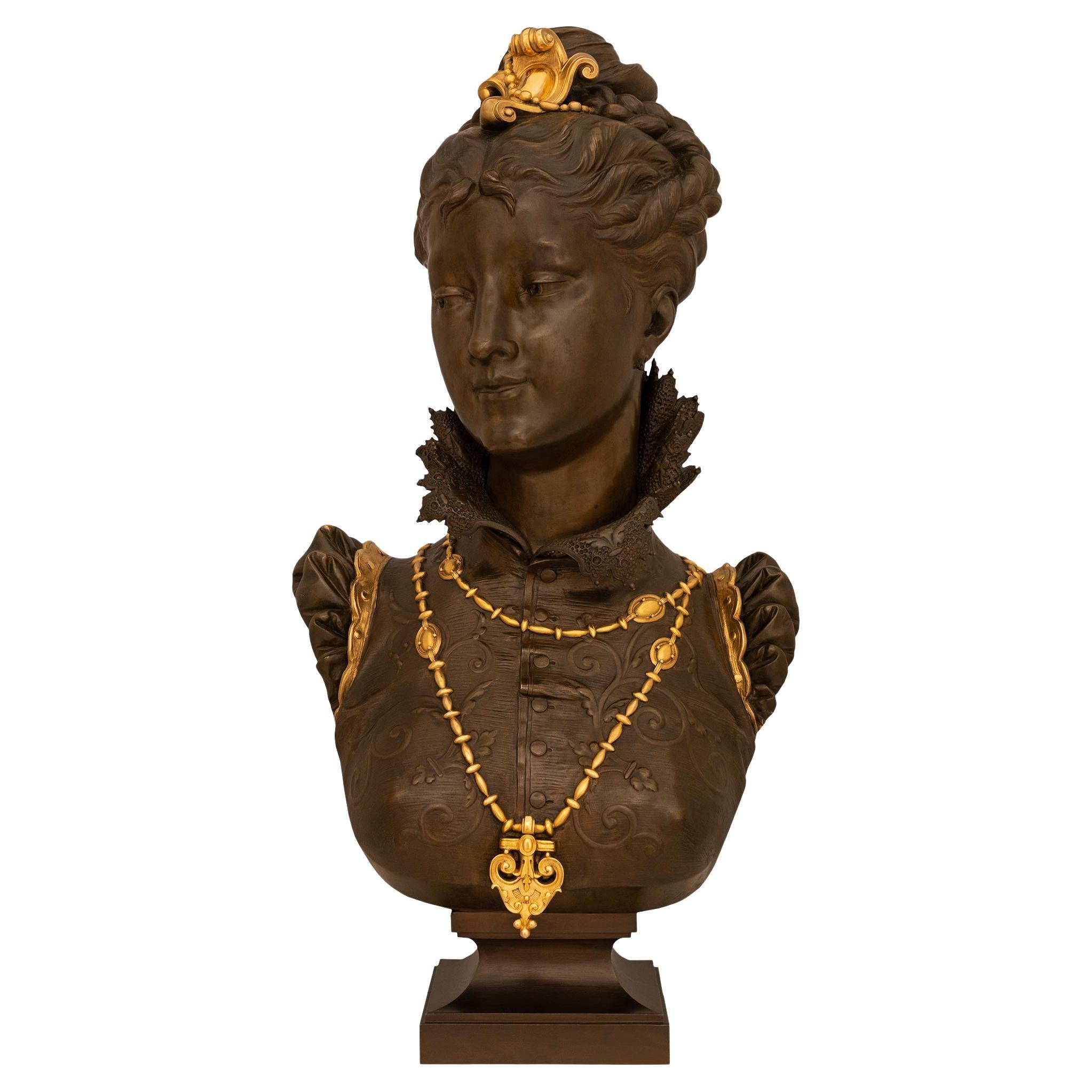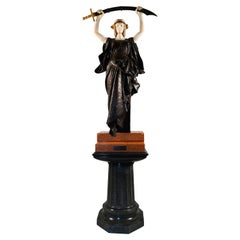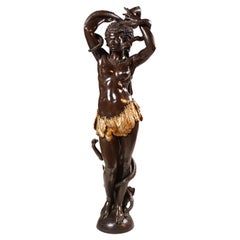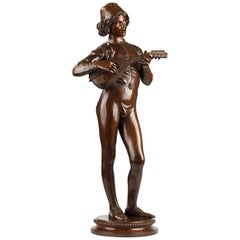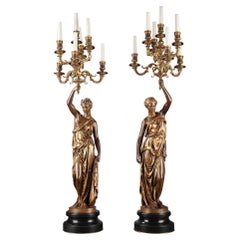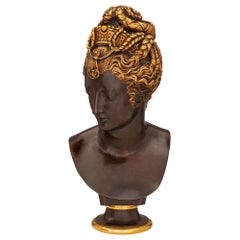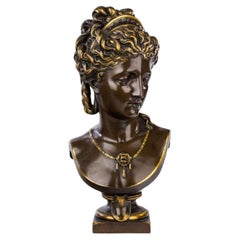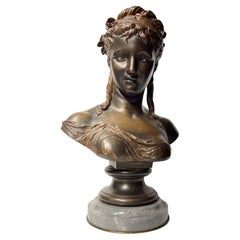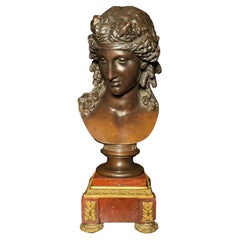Items Similar to Neo-Greek Bronze Bust by E. Cornu and G. Viot & Cie, France, Circa 1867
Want more images or videos?
Request additional images or videos from the seller
1 of 8
Neo-Greek Bronze Bust by E. Cornu and G. Viot & Cie, France, Circa 1867
$78,495.75
£57,941.25
€66,000
CA$108,355.93
A$120,716.27
CHF 63,329.51
MX$1,474,425.08
NOK 801,872.36
SEK 751,420.71
DKK 502,489.79
About the Item
Signed Machauld et Eug. Cornu – G. Viot et Cie Fondeurs
Bust of a Greek goddess, made entirely of silvered bronze and gilded bronze. The tiara and collar necklace ornating the bust are finely decorated with stylized floral motifs of polychrome champlevé enamel. It rests on a molded base and square plinth made in red griotte marble.
The sculptor Eugène Cornu (1827-1899), installed in Paris at N.29 rue Popincourt, after having worked as a designer and then director for the renowned company Tahan, worked closely with the « Compagnie des Marbres Onyx d’Algérie », led by Gustave Viot, successor of Alphonse Pallu. They produced luxurious furniture and art objects, incorporating onyx marble and bronze, with sometimes enamel, a combination then considered as a novelty and become quickly highly prized among wealthy collectors. They both showed at the 1867 Universal Exhibition held in Paris a fine pair of onyx, bronze and enamel vases (signed « G. Viot et Cie, Exposition de 1867, Eugène Cornu Inventeur » ; Catalogue Officiel de l’Exposition, groupe III, classe XIV, « meubles de luxe », n°65) for which Cornu and Viot won the Gold Medal (Rapports du Jury International, Exposition Universelle de 1867 à Paris, 1868, t. III, groupe III, classe XV, chapître II, § 2, p°45 & 46). Around 1873, Eugène Cornu became director of the Company, which took then the name of « Société des Onyx d’Algérie E. Cornu et Cie ».
The « Compagnie des marbres Onyx d’Algérie », led by G. Viot and named also « The Algerian Onyx-Marbles Co. », refering to the quarries of onyx the firm exploited near Oran, set up Boulevard des Italiens N.24, in Paris. Founded in the middle of the 19th century, that firm remained opened until the beginning of the 20th century. Onyx, although known since antiquity was not rediscovered until 1849 in Oran Province, Algeria, by Delmonte, a marble worker and fully exploited by Alphonse Pallu in the late 1850’s. The firm G. Viot & Cie produced, after models created by the most well-known sculptors, such as Eugène Cornu, Albert Carrier-Belleuse (Victoria & Albert Museum, Inv. 9070-1863), Charles Cordier (Orsay, Inv. RF 2996) ou Louis-Ernest Barrias (Orsay, Inv. RF 1409), luxuous furniture and art objects, incorporating onyx marbles and bronze, which awarded Viot medals at the various exhibitions, such the Gold Medal at the 1867 Paris Universal Exhibition. Around 1878 the company was then headed by H. Journet which it took his name.
- Creator:Eugène Cornu (Sculptor)
- Dimensions:Height: 25.2 in (64 cm)Width: 8.67 in (22 cm)Depth: 8.27 in (21 cm)
- Style:Greek Revival (In the Style Of)
- Materials and Techniques:
- Place of Origin:
- Period:
- Date of Manufacture:circa 1867
- Condition:Wear consistent with age and use.
- Seller Location:PARIS, FR
- Reference Number:Seller: 12591stDibs: LU3860318570542
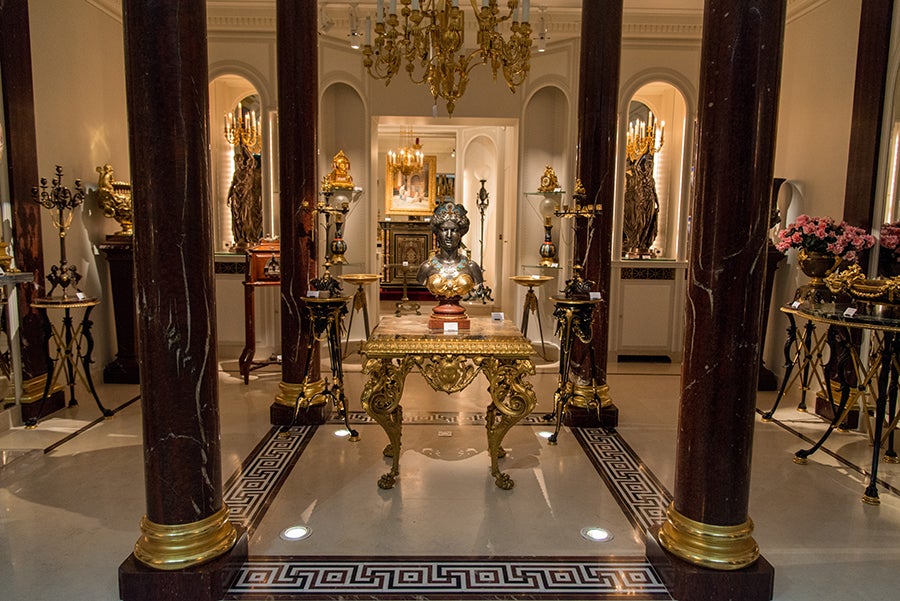
About the Seller
4.9
Vetted Professional Seller
Every seller passes strict standards for authenticity and reliability
Established in 1997
1stDibs seller since 2018
87 sales on 1stDibs
Typical response time: 1 hour
Associations
International Confederation of Art and Antique Dealers' Associations
- ShippingRetrieving quote...Shipping from: PARIS, France
- Return Policy
Authenticity Guarantee
In the unlikely event there’s an issue with an item’s authenticity, contact us within 1 year for a full refund. DetailsMoney-Back Guarantee
If your item is not as described, is damaged in transit, or does not arrive, contact us within 7 days for a full refund. Details24-Hour Cancellation
You have a 24-hour grace period in which to reconsider your purchase, with no questions asked.Vetted Professional Sellers
Our world-class sellers must adhere to strict standards for service and quality, maintaining the integrity of our listings.Price-Match Guarantee
If you find that a seller listed the same item for a lower price elsewhere, we’ll match it.Trusted Global Delivery
Our best-in-class carrier network provides specialized shipping options worldwide, including custom delivery.More From This Seller
View All"Giuditta" by Ezio Ceccarelli, Italy, Circa 1900
By Ezio Ceccarelli
Located in PARIS, FR
Great female statue of Judith in bronze with brown patina and white marble from Carrara. This young woman holds in her hands, stretched over his head, a scimitar in its scabbard, ready to draw it. The weapon is fitted with a hilt decorated by a stylized lion on the top of the sword guard...
Category
Antique Early 1900s Italian Beaux Arts Figurative Sculptures
Materials
Carrara Marble, Bronze
'African Venus' Bronze Sculpture by C. Marnyhac, France, Circa 1878
By Maison Marnyhac 1
Located in PARIS, FR
An exceptional life-size two patina bronze figure, representing a young African woman taming a snake, dressed with a feathered loincloth and a long drape in her hair, and wearing Afr...
Category
Antique 1870s French Figurative Sculptures
Materials
Bronze
"Florentine Singer" Bronze Sculpture by P. Dubois and F. Barbedienne, Circa 1880
By Paul Dubois, Ferdinand Barbedienne
Located in PARIS, FR
Signed P. Dubois 1865 and F. Barbedienne fondeur
Stamped with réduction mécanique Collas
A patinated bronze « Florentine Singer » sculpture, inspir...
Category
Antique 1880s French Figurative Sculptures
Materials
Bronze
Elegant Pair of Bronze Torcheres by F. Barbedienne, P. Dubois and A. Falguière
By Ferdinand Barbedienne, Paul Dubois, Jean Alexandre Joseph Falguière 1
Located in PARIS, FR
MODEL PRESENTED AT THE 1867 PARIS UNIVERSAL EXHIBITION
Listed in the Ferdinand Barbedienne’s catalogue as the “Deux femmes debout” (Two standing ladies)
Signed on each one P. Dubois – F. Barbedienne Fondeur and A. Falguière – F. Barbedienne Fondeur
Rare pair of parcel-gilt and patinated bronze figures, representing two women dressed in Antique style costume with jewels, each upholding a seven lights-arm candelabra. Standing on round bronze bases and black marble socles.
Paul Dubois (1827-1905) entered the Paris Beaux-Arts School in 1858. He exhibited at the 1865 Salon the Chanteur Florentin, illustrating Florentine sculpture, observed after his journey in Italy. This work, cast that time in silvered bronze, was exhibited at the 1867 Paris Universal Exhibition (now preserved at the Orsay museum). Dubois' success brought him many commissions, both private (Portrait of Duc d'Aumale) and public (Jeanne d'Arc, in Reims). Appointed curator at the Luxembourg museum in 1873, Dubois became also a member of the Institute and finally headmaster at the Beaux-Arts School in 1878.
Alexandre Falguière (1831-1900) studied under Jouffroy at the Paris Ecole des Beaux-Arts, began his career at the Paris Salon in 1857 and won as soon as 1859 the “Prix de Rome”. Falguière became very quickly successful and was several times awarded medals at the Salon, such in 1868 with his marble sculpture Tarcisius the Christian Boy-Martyr, or at the 1867 Paris Universal Exhibition, where he won the first medal in his category. Thanks to that success, he was immediately commissioned by private collectors as well as by the French State, whom asked him in 1878 to realize the Triomphe de la République, placed in 1881 at the summit of the Paris Arch of Triumph...
Category
Antique 1860s French More Lighting
Materials
Bronze
Neo-Greek Silvered Bronze Bowl Attributed to G. Servant, France, circa 1880
By Georges Emile Henri Servant
Located in PARIS, FR
Beautiful silvered bronze neo-Greek style bowl in a circular shape, adorned on the body with female masks in the antique style and on the sides with handles in the shape of busts of ...
Category
Antique 1880s French Greek Revival Decorative Bowls
Materials
Griotte Marble, Bronze
Large Neo-Greek Vase by F. Levillain & F. Barbedienne, France, circa 1890
By Ferdinand Levillain, Ferdinand Barbedienne
Located in PARIS, FR
After the model presented at the Universal Exposition in Paris in 1878
Important neo-Greek vase in the shape of an Amphora, made in two patina bronze. The body is decorated with a rich continuous frieze in bas-relief presenting a procession of characters carrying their offerings to the temple, underlined by a decoration of theatrical masks among olive trees. The 's'-scroll handles decorated with grape vines, resting only on the shoulder of the vase, are supported by a ram’s head. Numerous palmettes and friezes adorn the whole. Resting on a molded marble circular base.
Height without marble base : 116,5 cm
Biography
Ferdinand Levillain (Paris, 1837-1905) studied under the sculptor Jouffroy (1806-1882), before making his debut in 1861 at the French Artists Salon where he continued to exhibit until 1903. At the 1867 Universal Exhibition in Paris, he was praised for a Neo-Greek style bronze cup he made for the firm Blot and Drouard. He was not to become really famous, however, until 1871 thanks to his association with the great bronze founder Ferdinand Barbedienne, who began to exhibit Neo-Greek style lamps...
Category
Antique 1890s French Greek Revival Vases
Materials
Marble, Bronze
You May Also Like
French 19th Century Egyptian Revival St. Bronze and Ormolu Bust
By Ferdinand Barbedienne
Located in West Palm Beach, FL
An exceptional French 19th century Egyptian Revival st. Belle Époque period patinated bronze and ormolu bust, signed by F. Barbedienne. The wonderful bust is raised by an elegant cir...
Category
Antique 19th Century French Egyptian Revival Busts
Materials
Bronze, Ormolu
Barbedienne Bronze Neoclassical Female Bust by Eugene Aizelin Dated 1870
By Eugene-Antoine Aizelin
Located in New York, US
Our 19th century bronze bust of a lovely neoclassical female with diadem crown, known as Buste de Femme au Diadème, by Eugene Aizelin (French, 1821-1902) was cast by Barbedienne of P...
Category
Antique Late 19th Century French Neoclassical Revival Figurative Sculptures
Materials
Bronze
French Female Bronze Bust After Etienne Henri Dumaige
By Etienne-Henri Dumaige
Located in New York, NY
Antique (late 19th century) patinated bronze bust of a lovely female after the original model by the French master, Etienne Henri Dumaige, mounted on light blue marble plinth. 25 by...
Category
Antique Late 19th Century French Neoclassical Busts
Materials
Bronze
19th Century French Patinated Bronze Bust Of Ariadne
Located in Norwood, NJ
Antique 19th century French patinated bronze bust of Ariadne retailed by Tiffany & Co. Beautiful Grand Tour model mounted on a gilt bronze and rouge marble plinth. Marked Tiffany & Co. with inventory number.
The Antinous bust based on the Lansdown Antinous marble found at Hadrian’s Villa...
Category
Antique 19th Century French Grand Tour Busts
Materials
Bronze
Bronze Bust of a Classical Female Figure
Located in Bradenton, FL
19th Century Italian Patinated Bronze Bust of a Classical Woman, likely inspired by Greco-Roman goddesses or muses. The bust features finely detailed, flowing curls and an elegant ex...
Category
Antique 19th Century Italian Neoclassical Busts
Materials
Bronze
$1,475 / item
French late 19th century patinated Bronze and Ormolu bust of Raphaella
Located in West Palm Beach, FL
An elegant and most impressive French late 19th century patinated Bronze and Ormolu bust of Raphaella, signed Faure de Brousse. This beautiful bust depicts a Renaissance era princess...
Category
Antique Late 19th Century French Busts
Materials
Bronze, Ormolu
